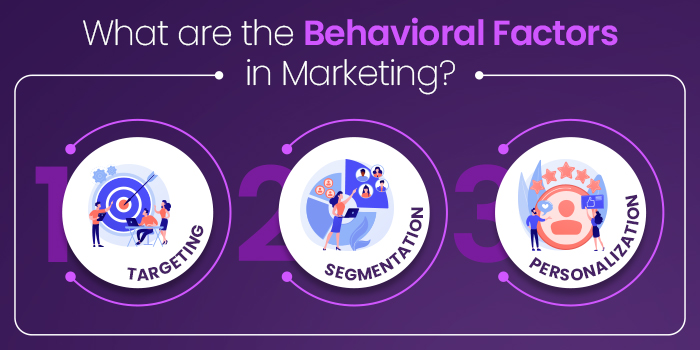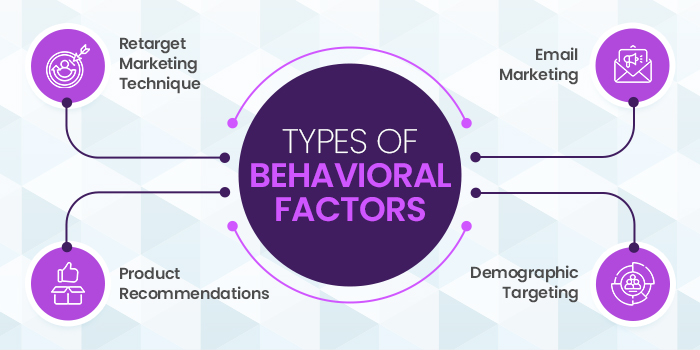Behavioral marketing is a transformation in how brands aspire to engage with their potential customers when utilizing its digital marketing channels and tools. So what is behavioral marketing? This is a technique to collect customer behavior data, specifically browsing behaviors, purchase behaviors, and engagement behaviors and leverage that knowledge to engage customers relative to targeted and personalized marketing initiatives.
Understanding how users interact with our websites and e-commerce websites enables us to use relevant messaging to apply to these behaviors, resulting in customer engagement and higher conversion rates for each respective user.
This transformation takes businesses from built-in communication to the right message at the right time, which is more effective and efficient communication.
What is Behavioral Marketing?
Behavioral marketing is a strategy that uses real-time user actions, like browsing pages, abandoning carts, clicking links, or even watching videos to tailor marketing experiences. In 2025, this approach combines AI with first-party data (from your own website or app) to deliver smarter, ethical, and more relevant campaigns across every touchpoint, web, email, social, and even SMS.
A marketer can craft highly personalized and targeted advertising campaigns if they understand these online behaviors. As a result of behavioral marketing, advertisements, and marketing messages are presented in a way that resonates deeply with the preferences and needs of each user.
As part of the analysis of collected data, which includes tracking cookies, IP addresses, and browsing habits, among other indicators, this level of customization is achieved.
Marketing communications should be relevant to increase engagement, conversion rates, and ultimately marketing investments’ effectiveness. Behavioral marketing goes beyond a one-size-fits-all approach by focusing on the specific interests and behaviors of users.
As a result, marketing efforts are not only seen but also meaningful and compelling to the recipient, resulting in a dynamic and responsive strategy that adapts to the changing preferences of the target audience.
What are the Behavioral Factors in Marketing?

Behavioral factors in marketing play a crucial role in shaping effective strategies that resonate with the target audience. These factors involve understanding consumer engagement patterns to create more impactful and effective marketing strategies. Here’s a breakdown of the key behavioral factors:
Targeting
Targeting is the process of finding particular sub-segments of a larger audience that are positively respond to your offering.Narrowing the market to those you identify as interested in or needing your offering makes marketing campaigns more impactful.
Segmentation
Segmentation divides the market into smaller segments based on certain behavioral characteristics. Among these characteristics are purchase history, browsing habits, product usage rates, and loyalty. Through understanding these segments, marketers can tailor their campaigns to address the needs and preferences of each group, making them more relevant and effective.
Personalization
Personalization tailors marketing messages and experiences to each individual based on insights gained from targeting and segmentation. It’s about using behavioral data to understand the preferences, needs, and actions of consumers, then delivering customized content, recommendations, and offers that speak directly to them.
By making the consumer feel understood and valued, personalization increases engagement and conversions.
Types of Behavioral Marketing Strategies

This personalization can lead to higher engagement rates, increased sales, and improved customer loyalty.
1. Retargeting Ads (Now AI-powered)
In retargeting, also referred to as remarketing, marketers show ads to users who visited a website but did not purchase. By tracking a user’s movements across the web, this technique serves them targeted ads that remind them of the products or services they have visited in the past.
In e-commerce, marketers display ads for products viewed or added to a cart but not purchased on different websites or social media sites.
Show ads to users who visited but didn’t buy. In 2025, AI predicts why they didn’t convert and displays more relevant visuals or offers
2. Email Marketing
Users are sent personalized emails based on previous interactions with the brand, such as previous purchases, website activity, or email engagement. It can be used for a variety of purposes, such as promoting sales, announcing new products, or offering personalized recommendations. Tools like Klaviyo or Mailchimp do this easily now.
“Are you looking for someone who can transform your brand’s visual identity and boost your sales with professional designs? Then you are at the right place!” Design Shifu’s subscription model starts at $199/month, offering unlimited graphic design requests and revisions for various needs, including email and social media.
With designs delivered in 24-48 hours and a 14-day money-back guarantee, it ensures quick, risk-free service. Dedicated designers, full design rights retention, flat-rate pricing, and no long-term contracts make it a flexible and cost-effective choice for small to medium-sized businesses aiming to enhance their sales efficiently. Click here to start your risk-free trial with Design Shifu and unlock unlimited graphic design potential for your business today!
3. Product Recommendations
The strategy analyzes a user’s past behavior, such as previous purchases or viewed items, to suggest other products they might be interested in. A common recommendation found on e-commerce sites is “you might also like” or “customers who bought this item also bought”.
4. Demographic Targeting
Demographic targeting, though not strictly behavioral, is often used alongside behavioral data to improve marketing messages by segmenting audiences based on their age, gender, income, education, etc. For example, targeting baby products at parents or luxury goods at high-end consumers is a good use for this type of data.
Best Practices to Succeed in Behavioral Marketing
To implement these best practices, you need to strike a balance between leveraging technology and creating genuine customer value. You can create more successful and engaging marketing campaigns if you understand and respect your audience’s preferences and privacy.
Comprehensive Data Collection
Collect data across various touchpoints, including website interactions, social media engagements, purchase history, and customer service interactions. Use cookies, tracking pixels, and CRM systems to gather detailed insights.
Behavioral Segmentation
Segment your audience based on their behavior, such as purchase history, browsing behavior, and content engagement. This allows for more targeted and personalized marketing efforts.
Predictive Analytics
Use predictive analytics to forecast future buying behaviors and preferences based on past behavior. This can help tailor marketing messages and offers that resonate with individual preferences.
Customized Content and Offers
Create personalized content and offers based on the user’s past behavior, preferences, and interactions. For example, if a user frequently purchases a particular type of product, you could send them targeted offers or content related to those interests.
Dynamic Content
Show different products or offers to different users based on their browsing history or purchase behavior on your website and in emails.
Touchpoint Analysis
Identify areas of friction and opportunities to enhance your customer’s experience at each touchpoint along the customer journey.
Retargeting Campaigns
Display ads for products they viewed on your website or abandoned in their shopping cart to re-engage users who have shown interest in your products but have not converted.
Transparency and Consent
Data protection regulations such as GDPR and CCPA require you to obtain consent from users before collecting their data.
Data Security
Ensure your data security practices are up-to-date and robust to prevent breaches of customer data.
Zero-Party Data Collection
Encourage users to willingly share preferences via quizzes, surveys, or preference centers.
AI-Enhanced Predictive Modeling
Predict what users want before they know it, based on micro-behaviors.
Behavioral Triggers in Omnichannel Campaigns
E.g., a click on a product in an email triggers a personalized SMS within 24 hours.
Respectful Retargeting
Limit ad fatigue by capping impressions and using storytelling in creatives.
Cookieless Tracking Alternatives
Discuss how brands are preparing for the loss of third-party cookies using tools like server-side tagging and Google’s Privacy Sandbox.
What is Behavioral Segmentation in Marketing?
A behavioral segmentation strategy in marketing divides a market into groups or segments based on consumer behavior patterns. In this approach, consumers are studied for their buying habits, spending patterns, product use, and overall interactions with brands across multiple channels to gain insight into how they behave.
Identifying and targeting specific customer segments with tailored marketing messages, offers, and products that are likely to resonate with their unique behaviors and preferences is essential.
The main types of behaviors used in segmentation include:
Purchase Behavior
The use of segmentation can help businesses tailor marketing efforts to encourage repeat purchases or target loyal customers with exclusive offers based on their purchasing habits, including frequency of purchases and brand loyalty.
Benefit Sought
Understanding what specific benefits or values customers are looking for in a product or service. This allows companies to highlight those benefits in their marketing campaigns to attract customers seeking those particular features.
User Status
Making distinctions between non-users, potential users, first-time users, regular users, and former users. Re-engagement campaigns for former users or loyalty programs for regular users can then be tailored to each group’s needs and behaviors.
Usage Rate
Segmenting customers based on how frequently they use a product or service, such as light, medium, or heavy users. This can inform targeted offers, like upselling higher usage plans to light users or rewarding heavy users to enhance loyalty.
Occasion or Timing
Customers can be segmented according to specific occasions and times when they are more likely to buy or engage with a brand, such as holidays, birthdays, or time of day. Tailor-made promotions can be sent out during these high-intent times.
Customer Loyalty
Identifying and segmenting customers based on their loyalty levels to focus on retaining highly loyal customers and improving relationships with less loyal segments through personalized engagement and loyalty programs.
Difference Between Behavioral Marketing and Behavioral Economics
The table below outlines the key differences between Behavioral Marketing and Behavioral Economics, highlighting their distinct focuses, methodologies, and applications
| Aspect | Behavioral Marketing | Behavioral Economics |
| Focus | Concentrates on understanding and leveraging consumer behavior patterns for more effective marketing campaigns. | Examines the psychological, social, cognitive, and emotional factors influencing economic decisions of individuals and institutions. |
| Objective | To enhance marketing effectiveness by personalizing communication, offers, and products based on observed behavior. | To understand and predict economic behaviors, often challenging the assumption of rational decision-making in traditional economics. |
| Methodology | Utilizes data analytics, segmentation, and predictive modeling to tailor marketing efforts according to consumer behavior. | Employs psychological experiments, surveys, and analysis to study decision-making processes and their effects on market outcomes. |
| Application | Applied in designing targeted advertising campaigns, content marketing, product recommendations, and customer engagement strategies. | Applied in policy-making, financial planning, pricing strategies, and understanding market dynamics and consumer welfare. |
| Data Sources | Relies on consumer interaction data, such as purchase history, web browsing patterns, and social media engagement. | Uses experimental data, surveys, and real-world economic situations to analyze decision-making patterns. |
| Outcome | Aims to increase conversion rates, customer loyalty, and overall marketing ROI by delivering more relevant and engaging experiences to consumers. | Seeks to provide insights into economic anomalies, improve economic policies, and enhance individual and collective decision-making through a better understanding of biases and heuristics. |
| Tools and Techniques | Employs CRM systems, marketing automation tools, web analytics, and behavioral targeting technologies. | Utilizes statistical analysis, experimental economics methods, and behavioral models to analyze economic decisions. |
Challenges and Solutions in Behavioral Marketing
Behavioral marketing involves leveraging consumer behavior data to tailor marketing efforts. Below, we discuss some of the challenges, along with potential solutions to help businesses navigate these complexities.
Challenges in Behavioral Marketing
Data Privacy and Regulation
Increasing concern over data privacy and the implementation of strict regulations like GDPR and CCPA make it challenging to collect and utilize consumer data.
Ensure compliance by being transparent about data collection methods, securing explicit consent from users, and implementing robust data protection measures.
Data Accuracy and Integration
Collecting accurate and comprehensive data from various sources can be difficult, and integrating this data to form a unified customer view is often technically challenging.
Invest in advanced data management platforms (DMPs) and customer relationship management (CRM) systems that can aggregate and harmonize data from multiple sources.
Overload of Information
The sheer volume of data can be overwhelming, making it hard to extract meaningful insights without sophisticated analysis tools. Utilize advanced analytics, AI, and machine learning algorithms to sift through large datasets, identify patterns, and predict consumer behavior more effectively.
Ensure Personalization at Scale
Delivering personalized marketing messages to large audiences without appearing intrusive or irrelevant can be challenging. Leverage automation tools and dynamic content generation technologies to personalize interactions at scale while maintaining a balance between relevance and privacy.
Keep Up with Changing Consumer Behavior
Consumer preferences and behaviors can change rapidly, making it difficult for marketers to keep up. Implement real-time analytics and agile marketing strategies that can adapt to changing trends and behaviors quickly.
Ethical Concerns
There’s a fine line between personalized marketing and invasive surveillance, raising ethical concerns about consumer manipulation. Adopt ethical guidelines for behavioral marketing practices that respect consumer autonomy and avoid manipulative tactics.
Solutions in Behavioral Marketing
Robust Privacy Practices
Develop a privacy-first approach that respects user consent and data protection laws, building trust with your audience.
Advanced Analytics and AI
Employ artificial intelligence and machine learning to process and analyze data efficiently, extracting actionable insights without manual intervention.
Integrated Technology Stack
Use integrated marketing technologies that can seamlessly collect, analyze, and activate data across all customer touchpoints.
Consumer Education
Educate consumers on how their data is being used for personalization, highlighting the benefits they receive in exchange for their data.
Continuous Optimization
Regularly review and adjust marketing strategies based on analytics and consumer feedback to ensure relevance and effectiveness.
Ethical Marketing Practices
Establish and adhere to ethical standards in marketing, focusing on adding value to the consumer experience without exploiting behavioral data.
Behavioral Marketing Examples
As a result of behavioral marketing, marketing messages and offers are tailored to individual consumers based on their behavior. The following examples illustrate how behavioral marketing can be used across various channels and industries
Retargeting Ads
Cookie tracking on an online retailer’s website is an example. The retailer displays ads for products the user viewed or added to their cart on social media and other websites when they leave without making a purchase. By doing so, the user is encouraged to complete the purchase on the retailer’s site.
Personalized Email Campaigns
An email recommendation from a music streaming service based on a user’s listening history is an example. In case a user frequently listens to jazz, they might receive emails highlighting new jazz albums, upcoming jazz concerts, or exclusive playlists.
“Ready to jazz up your email marketing?” Let Design Shifu’s custom email design services bring rhythm to your promotions. With our tailored designs, crafted to match your audience’s listening habits, your jazz-themed campaigns will hit all the right notes.
Experience rapid turnarounds, unlimited revisions, and dedicated designers turning your email campaigns into engaging masterpieces. Click here to make every note count with Design Shifu!“
Product Recommendations
A customer’s previous purchases and browsing habits are analyzed by machine learning algorithms on an e-commerce platform. As a result of this analysis, it recommends items the customer is likely to be interested in on the homepage or product pages.
Dynamic Pricing
Using various factors, including the user’s search history, the popularity of the destination, and the amount of time left before departure, a travel booking site adjusts the price of flights and hotels in real time. By creating a sense of urgency or by offering deals tailored to their interests and timing, this approach can motivate users to book sooner.
Content Customization
As an example, a news website segments its visitors based on their reading habits and interests. As a result, each visitor’s news feed on the homepage is tailored to their interests and reading habits, increasing engagement and time spent on the site.
Social Media Targeting
As an example, a fitness app creates targeted social media campaigns based on data from its users’ workout histories. Ads highlighting wellness and mindfulness content are displayed for yoga and meditation users, while ads featuring new high-intensity workouts appear for strength training users.
Loyalty Programs
To send personalized offers, a coffee shop chain analyzes its loyalty program members’ purchase data. A member who frequently orders a particular coffee may receive discounts, while someone who visits in the afternoons might receive offers that encourage them to visit in the morning.
Frequently Asked Questions
What is Behavioral Data in Marketing?
Behavioral data in marketing refers to information collected about consumers’ actions, such as purchase history, website visits, and engagement with ads, used to create personalized marketing strategies.
What is an example of a Behavioral Social Marketing Campaign?
An example of a behavioral social marketing campaign is a public health initiative that uses social media engagement data to target messages promoting healthy behaviors to specific demographics based on their online activities.
What is Behavioral Advertising?
Behavioral advertising is a technique that uses consumer behavior data, such as browsing history and purchase activities, to display targeted ads to individuals
What is the Meaning of Behavioral Targeting?
Behavioral targeting involves segmenting consumers based on their behavior (e.g., web browsing, purchases) to deliver personalized advertising and content more likely to resonate with their interests and needs.
How Does a Marketer Demonstrate Respect for Target Customers?
A marketer demonstrates respect for target customers by prioritizing privacy, obtaining consent for data use, providing clear opt-out options, and delivering content that adds value without being intrusive or exploitative.





